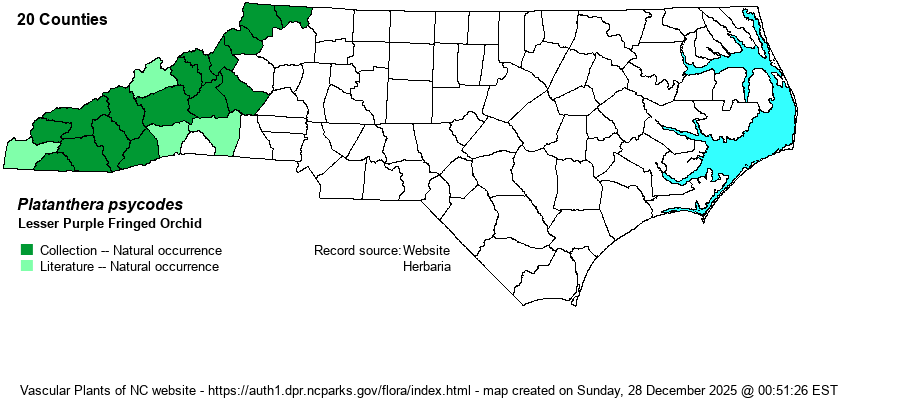| Author | (L.) Lindley | |
| Distribution | Essentially throughout the Mountains; not present downstate. Not restricted to higher elevations as is Platanthera grandiflora.
A Northern species that ranges from Newf. to Man. south to NJ, PA, and IA, and then mainly in the Appalachians south to northern GA. | |
| Abundance | Uncommon to infrequent, mainly in middle elevations. Nonetheless, it is the most numerous of the four purple-flowered montane orchids. | |
| Habitat | This is a species of rich and mostly shaded, moist places, most often found along seepages in Northern Hardwood Forests or Rich Cove Forests. However, it also is found in bogs and a few damp places in at least partial shade. | |
| Phenology | Blooms from June to August, and fruits shortly after blooming. The main flowering in NC is from mid-July to early August, about 3-4 weeks after the flowering of P. grandiflora in the same location/elevation. | |
| Identification | This is an attractive orchid with a fairly dense flower cluster of lilac to light purple flowers. The stem grows about 1-2 feet tall, with a raceme of several dozen fringed flowers that averages 3-4 inches tall. As with other species in the genus, there are several ascending leaves on the lower part of the stem. This species and P. grandiflora, which was included with P. psycodes in the same species for many decades, can be easily confused. However, P. psycodes has smaller flowers (about 1/2-2/3-inch across), a flower spur that is about 2/3-inch long, and especially has the nectary opening in the shape of a dumbbell, with two obvious holes. P. grandiflora has flowers often 1 inch across, a spur that is also over 1 inch long, and the nectary opening is a single round hole. The recently described P. shriveri is similar, with lilac or pale purple flowers, but the lips are extremely divided and look quite "frilly"; the nectary opening is angled at the top. | |
| Taxonomic Comments | This species was formerly named as Habenaria psycodes. That species had often been split into two varieties -- var. psycodes and var. grandiflora. However, most recent references have split out the two as full species, perhaps owing to the quite different nectary opening shape.
| |
| Other Common Name(s) | Small Purple Fringed Orchid, Lesser Purple Fringed Bog Orchid. | |
| State Rank | S3 | |
| Global Rank | G5 | |
| State Status | | |
| US Status | | |
| USACE-agcp | FACW link |
| USACE-emp | FACW link |

